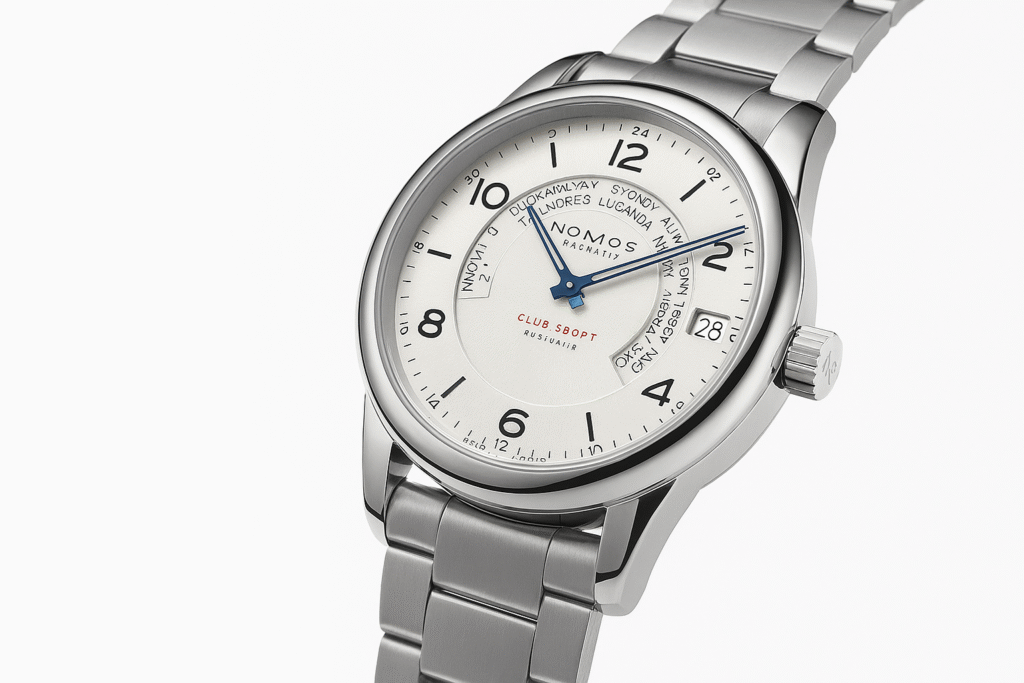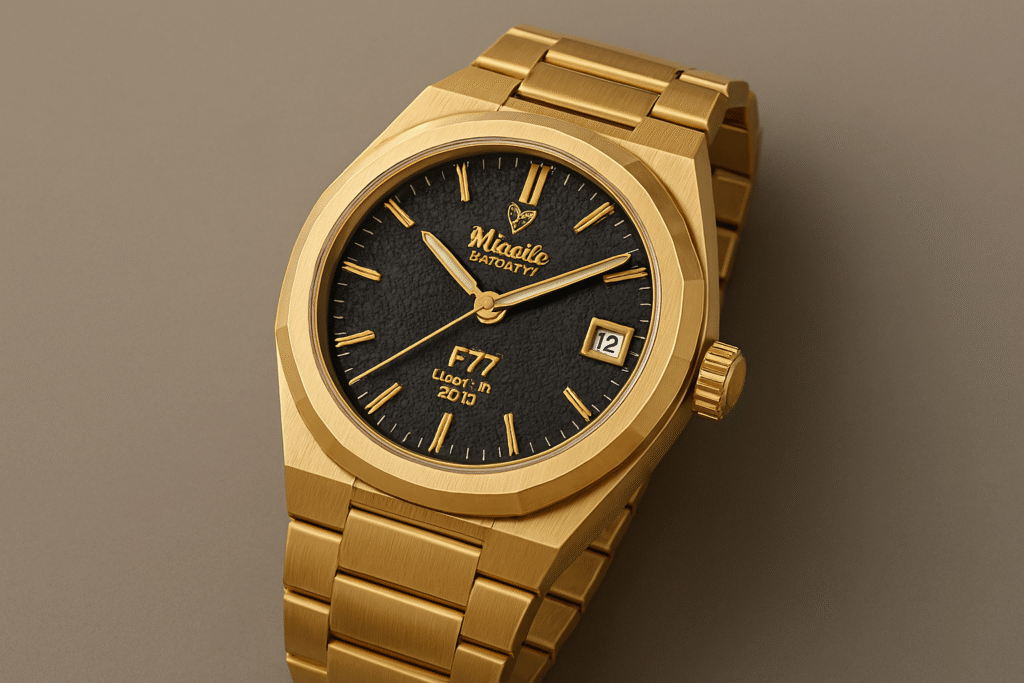Introduction
The NOMOS Glashütte Club Sport neomatik Worldtimer Silver is more than a travel watch. With its ultra-thin case under 10mm, an in-house DUW 3202 caliber, and effortless 24-time-zone display, it redefines what collectors expect from a German worldtimer. This review explains why it’s becoming a benchmark for modern luxury travel watches.
Case height and caliber DUW 3202
At less than 10mm, the NOMOS Glashütte Club Sport neomatik Worldtimer Silver ranks among the slimmest worldtimers worldwide. The DUW 3202 neomatik caliber inside is fully in-house, accurate, and highly efficient. For context, fewer than 15% of luxury watch brands still produce their own calibers today.
Effortless worldtime function
Switching time zones is simple. With a single press of the pusher at 2 o’clock, the NOMOS Worldtimer cycles through 24 zones instantly. Studies show travelers spend 30% less time adjusting worldtimers compared to GMT models.
Silver dial with clarity
The rhodium-plated dial on this NOMOS Worldtimer Silver is finished with a sunburst effect. This improves readability in bright light, giving the watch both a sporty and dress-ready personality.
Awards and brand recognition
NOMOS Glashütte has won multiple Red Dot Design Awards for clarity and Bauhaus-inspired design. Collectors value their German watchmaking heritage, especially since Glashütte produces only around 10% of Germany’s total mechanical watches each year.
Expert insights
“The key is clarity. Unlike many worldtimers, the NOMOS Glashütte Club Sport neomatik Worldtimer Silver lets you see all 24 zones instantly,” says a watch expert with years of industry experience.
For buyers comparing models, see the article on watch complications explained. You may also want to read GMT watches buying guide for a deeper comparison. Explore luxury watch care tips.
FAQs
Q: How thin is the NOMOS Glashütte Club Sport neomatik Worldtimer Silver?
A: It measures under 10mm, slimmer than most worldtimers in the market.
Q: Does it use an in-house caliber?
A: Yes, the DUW 3202 is fully designed and built by NOMOS in Glashütte.
Q: Is it suitable for frequent travel?
A: Absolutely. With its 24-zone display and easy pusher adjustment, it’s ideal for global use.
Q: What makes it different from a GMT watch?
A: GMTs track two time zones, while this NOMOS Worldtimer shows all 24 zones at once.
Q: Where can I learn more about worldtimers?
A: See German watchmaking heritage for background. For external references, check trusted sources like Hodinkee.
This comprehensive global cuisine FAQ covers everything about Asian and Western food and drinks. Whether you’re exploring international cooking techniques or discovering new flavors, this global cuisine FAQ answers the most frequently asked questions about world food traditions, ingredients, and culinary practices from both Eastern and Western cultures.
Global Cuisine FAQ: Asian & Western Food & Drinks
Food reveals cultural contrasts in clear and delicious ways. From cooking methods to dining customs, Asian and Western cuisines showcase unique traditions while also offering fascinating overlaps. Below, you’ll find answers to the most common questions about these culinary worlds.
Understanding Core Differences in Cuisine
1. What distinguishes Asian and Western culinary traditions?
Asian meals often rely on rice or noodles as a foundation. Flavors usually come from soy sauce, ginger, garlic, and a wide variety of spices. Meanwhile, Western gastronomy emphasizes bread, potatoes, and pasta. Dairy plays a key role, with butter, cream, and cheese giving richness to many dishes. Herbs such as rosemary and thyme highlight European cooking. These contrasts create distinct dining habits and flavor profiles.
2. Are Asian dishes always spicy?
No, not at all. While cuisines from Thailand and parts of India feature bold use of chilies, not every dish follows this pattern. Japanese sushi, Chinese dim sum, and Korean bulgogi are mild examples. In fact, Asian cuisines range from fiery to delicate, showcasing a rich palette of flavor.
Western Breakfast Staples and Comfort Foods
1. What constitutes typical Western morning meals?
Western breakfasts often include eggs, bacon, and toast. Pancakes, waffles, and cereal are also popular choices. These hearty starts are usually enjoyed with coffee, tea, or juice, providing both energy and comfort.
2. What represents popular Western comfort foods?
Comfort foods in the West speak to nostalgia and indulgence. Creamy macaroni and cheese, pizza, and hearty casseroles are favorites. Similarly, burgers and fried chicken have wide appeal. Because they are warm, filling, and familiar, these dishes strongly connect to emotion.
Cultural Dining Practices
1. Do all Asian cultures employ chopsticks?
No. Chopsticks dominate in East Asia—China, Japan, and Korea. However, Southeast Asia prefers spoons and forks, while India and parts of the Middle East often use flatbreads or hands. This diversity highlights how food customs closely reflect culture.
2. Why are some Asian foods fermented?
Fermentation preserves food while also enhancing nutrition and flavor. Korean kimchi, Japanese miso, and Indonesian tempeh show how tradition meets health benefits. These foods are valued not only for taste but also for their role in well-being.
Common Western Beverages
1. What beverages are common with Western meals?
Western dining often features water, soda, or fresh juice. Alcohol also has a strong cultural connection, with wine served at European dinners and beer central in North America. In the southern United States, sweet iced tea is a staple.
Dietary Flexibility and Options
1. Can one discover plant-based options easily?
Yes. Asian cuisines offer tofu stir-fries, lentil dals, and vegetable curries that are naturally vegetarian. Western food, similarly, embraces plant-based eating. Salads, vegetarian pastas, and vegan burgers have grown popular, making meat-free dining accessible worldwide.
Unique Asian Drinks to Explore
1. What are some unique Asian beverages?
Asia provides a wide variety of distinctive drinks. Bubble tea, from Taiwan, combines tea with chewy tapioca pearls. Japanese sake, made from rice, holds deep cultural meaning. Strong Vietnamese iced coffee, sweetened with condensed milk, adds a bold twist compared to Western brews.
Portion Sizes and Dining Habits
1. How do portion sizes compare?
Western meals often emphasize large servings, reflecting abundance. By contrast, Asian meals are usually smaller yet balanced, encouraging sharing and mindful eating. This creates different social experiences around the table.
The Art of Fusion Cuisine
1. Is it feasible to integrate Asian and Western flavors?
Absolutely. Fusion cuisine blends traditions in creative ways. For instance, teriyaki burgers combine Japanese flavors with American fast food, while kimchi tacos bring Korean spice to Mexican street food. These playful mixes show how food bridges cultures.


